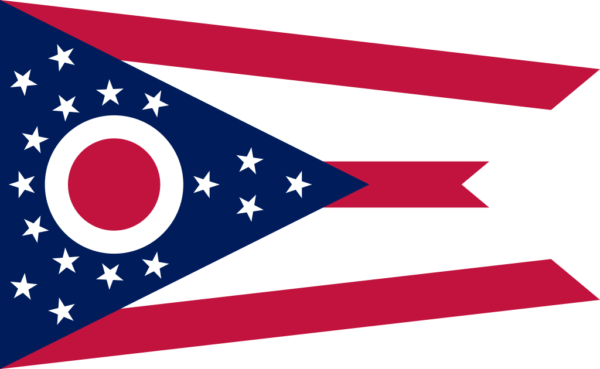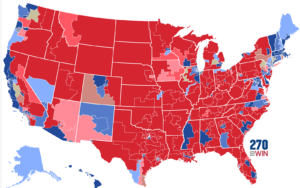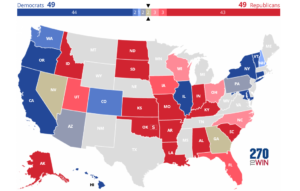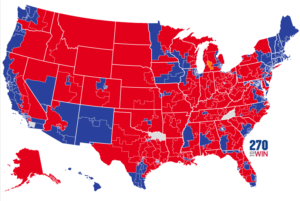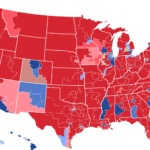As we prepare for the 2020 elections, Yesh Ginsburg and Steen Kirby will give a general overview of all 435 United States House of Representatives races. This is a basic overview to introduce you to the major candidates. All Partisan Lean numbers are taken from the Cook Partisan Voting Index. We will update this page as the races progress if anything noteworthy arises.
Ohio is too big to cover in one article, with 16 Congressional districts. This article will focus on the first eight districts, which contain mostly rural Republican districts, along with one Democratic Columbus district. The second article will contain three of the Democrats’ four districts in the state, in the northern Ohio areas.
Ohio’s 1st Congressional District
Incumbent: Steve Chabot (Republican, fifth term)
Partisan Lean: R+5
2018 Results:
| Candidate | Votes | % |
| Steve Chabot (R) | 154,409 | 51.32 |
| Aftab Pureval (D) | 141,118 | 46.9 |
| Dirk Kubala (L) | 5,339 | 1.78 |
2016 Results:
| Candidate | Votes | % |
| Steve Chabot (R) | 210,014 | 59.19 |
| Michele Young (D) | 144,644 | 40.77 |
Republican Candidate:
Steve Chabot (campaign website)
Chabot is a moderate Republican who consistently manages to hold this district, though it turned into a swing district in 2018. If it continued shifting towards the Democrats like it did over the last two years, then Chabot is in trouble.
Democratic Candidate:
Kate Schroder (campaign website)
Schroder is a somewhat liberal Democrat, attacking Chabot on his voting record on issues like guns and healthcare. Both candidates are well-funded in this race, and expect this toss-up to be a tight battle in November.
Ohio’s 2nd Congressional District
Incumbent: Brad Wenstrup (Republican, fourth term)
Partisan Lean: R+9
2018 Results:
| Candidate | Votes | % |
| Brad Wenstrup (R) | 166,714 | 57.56 |
| Jill Schiller (D) | 119,333 | 41.2 |
| Jim Condit Jr. (I) | 3,608 | 1.25 |
2016 Results:
| Candidate | Votes | % |
| Brad Wenstrup (R) | 221,193 | 65 |
| William Smith (D) | 111,694 | 32.82 |
| Janet Everhard (D write-in) | 7,392 | 2.17 |
Republican Candidate:
Brad Wenstrup (campaign website)
Wenstrup is a consistent Republican vote who campaigns on his conservative record and an “Ohio first” platform. He rarely struggles in this safe red seat.
Democratic Candidate:
Jaime Castle (campaign website)
Castle is a liberal Democrat running on a pretty standard Democratic Party slate of beliefs, and arguing against Chabot’s conservatism. She’s actually spending a bit of money in this race, which is a little odd for a seat this safe.
Ohio’s 3rd Congressional District
Incumbent: Joyce Beatty (Democratic, fourth term)
Partisan Lean: D+19
2018 Results:
| Candidate | Votes | % |
| Joyce Beatty (D) | 181,575 | 73.61 |
| Jim Burgess (R) | 65,040 | 26.37 |
22016 Results:
| Candidate | Votes | % |
| Joyce Beatty (D) | 199,791 | 68.57 |
| John Adams (R) | 91,560 | 31.43 |
Republican Candidate:
Mark Richardson (campaign website)
Richardson is a conservative running on his history as a veteran. His campaign website requires visitors to sign up for his email list to view his platform.
Democratic Candidate:
Joyce Beatty (campaign website)
Beatty is a popular incumbent in this deep blue Columbus-area district. Her policies range from moderate to liberal, and she campaigns on her record and her involvement in the community.
Ohio’s 4th Congressional District
Incumbent: Jim Jordan (Republican, seventh term)
Partisan Lean: R+14
2018 Results:
| Candidate | Votes | % |
| Jim Jordan (R) | 167,993 | 65.26 |
| Janet Garrett (D) | 89,412 | 34.74 |
2016 Results:
| Candidate | Votes | % |
| Jim Jordan (R) | 210,227 | 67.99 |
| Janet Garrett (D) | 98,981 | 32.01 |
Republican Candidate:
Jim Jordan (campaign website)
Jordan is a consistent Republican and close ally of President Trump. He’s running on his support for the President and his relatively high ranking within the Republican Party.
Democratic Candidate:
Shannon Freshour (campaign website)
Freshour is a moderate Democrat who is actually spending some serious money in this race. Her donations can’t compare to Jordan’s war chest, but she’s forcing the issue here. The campaign push comes from anti-Trump sentiment, as well as the sexual abuse scandal at Ohio State University while Jordan was an assistant wrestling coach there.
Ohio’s 5th Congressional District
Incumbent: Bob Latta (Republican, seventh term)
Partisan Lean: R+11
2018 Results:
| Candidate | Votes | % |
| Bob Latta (R) | 176,569 | 62.26 |
| John Galbraith (D) | 99,655 | 35.14 |
| Don Kissick (L) | 7,393 | 2.61 |
2016 Results:
| Candidate | Votes | % |
| Bob Latta (R) | 244,599 | 70.9 |
| James Neu, Jr. (D) | 100,392 | 29.1 |
Republican Candidate:
Bob Latta (campaign website)
Latta is a conservative Republican who pushes for lower spending, and sticks to his record as a pro-life and pro-gun politician.
Democratic Candidate:
Nick Rubando (campaign website)
Rubando is a very liberal Democrat running on a plethora of left-wing policies, including Medicare for All. He is mainly campaigning against Latta’s personal history as well as Latta’s connection to President Trump.
Ohio’s 6th Congressional District
Incumbent: Bill Johnson (Republican, fifth term)
Partisan Lean: R+16
2018 Results:
| Candidate | Votes | % |
| Bill Johnson (R) | 172,774 | 69.25 |
| Shawna Roberts (D) | 76,716 | 30.75 |
2016 Results:
| Candidate | Votes | % |
| Bill Johnson (R) | 213,975 | 70.68 |
| Michael Lorentz (D) | 88,780 | 29.32 |
Republican Candidate:
Bill Johnson (campaign website)
Johnson is a conservative Republican who focuses mainly on the economy, including protecting coal jobs in his section of Ohio. He campaigns on cutting taxes and spending, as well as even Congressional salaries.
Democratic Candidate:
Shawna Roberts
Roberts earned about 30% in 2018, and she’s on the ballot again. She does not have a campaign website and she does not seem to be spending any money or aggressively campaigning in this race.
Ohio’s 7th Congressional District
Incumbent: Bob Gibbs (Republican, fifth term)
Partisan Lean: R+12
2018 Results:
| Candidate | Votes | % |
| Bob Gibbs (R) | 153,117 | 58.74 |
| Ken Harbaugh (D) | 107,536 | 41.26 |
2016 Results:
| Candidate | Votes | % |
| Bob Gibbs (R) | 198,221 | 64.03 |
| Roy Rich (D) | 89,638 | 28.96 |
| Dan Phillip (I) | 21,694 | 7.01 |
Republican Candidate:
Bob Gibbs (campaign website)
Gibbs is a small government conservative running on his record, as well as cutting regulations, taxes, and government spending.
Democratic Candidate:
Quentin Potter (campaign website)
No Democrats filed for this race initially, so Potter earned his spot on the November ballot with a write-in primary campaign. His campaign is based on fighting back against Republican policies.
Ohio’s 8th Congressional District
Incumbent: Warren Davidson (Republican, second term)
Partisan Lean: R+17
2018 Results:
| Candidate | Votes | % |
| Warren Davidson (R) | 177,852 | 66.58 |
| Vanessa Enoch (D) | 89,451 | 33.42 |
2016 Results:
| Candidate | Votes | % |
| Warren Davidson (R) | 223,833 | 68.76 |
| Steve Fought (D) | 87,794 | 26.97 |
| Derrick Hendricks (G) | 13,879 | 4.26 |
Republican Candidate:
Warren Davidson (campaign website)
Davidson is a generally conservative Republican, though he is more moderate on some issues, like Social Security. He is popular in this district and should be safe in this deep red seat.
Democratic Candidate:
Vanessa Enoch (campaign website)
Enoch is campaigning on Davidson’s record, claiming that he has voted the wrong way on issues related to the economy, welfare, and foreign policy, among others. She is not spending heavily, which makes sense given the district.
Overview
Republicans control seven of these eight seats. Only one of these districts (the first) should be competitive in November, but there are interesting notes in other races as well.
Interested in the rest of our primers for other House races? We have them all listed on our primer home page.

